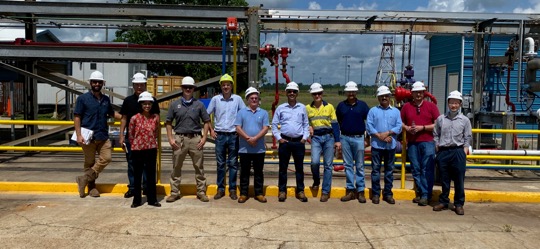LSU PETE Faculty, ExxonMobil URC Study Gas Migration at PERTT Lab
August 3, 2022
 BATON ROUGE, LA – ExxonMobil Upstream Research Company (URC) has joined forces with
LSU Craft & Hawkins Department of Petroleum Engineering (PETE) faculty to conduct
gas migration experiments as part of a financial grant from ExxonMobil URC. The one-year
project is meant to improve safety and operational efficiencies in oil and gas while
also making advancements in academia and industry.
BATON ROUGE, LA – ExxonMobil Upstream Research Company (URC) has joined forces with
LSU Craft & Hawkins Department of Petroleum Engineering (PETE) faculty to conduct
gas migration experiments as part of a financial grant from ExxonMobil URC. The one-year
project is meant to improve safety and operational efficiencies in oil and gas while
also making advancements in academia and industry.
LSU PETE Professional in Residence Mauricio Almeida is the principal investigator on the project, with LSU PETE Assistant Professors Jyotsna Sharma and Yuanhang Chen and LSU PETE Professional in Residence Otto Santos working on the project as well.
Gas migration occurs when gas enters a well and migrates up the wellbore towards the surface, which can lead to potentially dangerous situations if unchecked.
“When we’re drilling a well offshore, we have the possibility of exposing formations where we have gas or oil,” Almeida said. “For safety, we don’t allow gas to enter the well. However, sometimes it happens. We call it a ‘kick.’ Once gas enters the well, we have techniques to get the gas out of the well in a safe manner. If we don’t do that, we could get into an uncontrolled situation where the gas can go to the surface and result in a well blowout.”
Almeida says that the problem is not having all of the answers on how to control the kick. Understanding how this phenomenon happens is important in order to find answers. One technique used today called managed pressure drilling allows workers to control the well with gas inside, but knowing if the pressure is building up is critical so it doesn’t overcome the limit of the surface equipment.
It’s also important to know how the gas behaves while in the well to determine when they may want to pump the gas back down.
“In order to understand how the gas behaves, we have a theoretical approach, which involves developing mathematical models that can give an idea of what happened,” Almeida said. “But, the models are not always 100% precise and need to be validated against real data to see if the modeling is working. That’s where our facilities and wells come into play.”
LSU’s Petroleum Engineering Research, Training & Testing (PERTT) Lab provides Almeida’s team and ExxonMobil URC with an industrial-scale facility with full-scale equipment and instrumentation for conducting research related to petroleum technology.
“The reason we approached LSU for this project is because we were looking for a test facility where we could do gas migration tests in synthetic-based mud in a real test well with downhole instrumentation,” ExxonMobil URC Senior Research Engineer Sai Rao said. “The LSU PERTT well is unique in the nation—a fully-instrumented 5,000-ft. well with downhole pressure and temperature gauges. Further, it has a fiber optic measurement system in the well, which sets it apart. These capabilities together with the expertise of the LSU faculty, lab staff, and graduate students, created the perfect ecosystem to solve this challenging problem and advance the fundamental science of downhole gas migration for the entire industry.”
“We are excited about the collaborative research program with LSU PERTT and faculty in petroleum engineering,” said Paul Gupta, team lead, ExxonMobil URC. “With the unique test well at PERTT and the faculty expertise in well control and downhole instrumentation including fiber optics, we are studying the behavior of gas deep down in drilling scenarios. This is a first of its kind study and comes as close to being able to ‘see’ downhole in real time without a camera. This work will benefit our industry in better planning of drilling operations, conserving resources, and improving safety. There will likely be other non-drilling applications related to gas behavior in wells.”
The first phase of the project is complete, and the team is currently planning the next phase.
“Even when this project is complete, this topic is something that will still be worked on,” Almeida said. “LSU hopes to work with ExxonMobil URC again on similar projects in the future.”
Like us on Facebook (@lsuengineering) or follow us on Twitter and Instagram (@lsuengineering).
###
Contact: Libby Haydel
Communications Specialist
225-578-5706
ehaydel1@lsu.edu